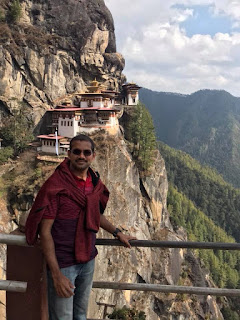 |
| Paro Valley |
Our visit started at Paro, the only place in Bhutan with an international airport. As the country, that's full of valleys and beautiful landscapes, doesn't have any flat-land at all, it must have been hard to find a place for large planes to land. Paro valley is the widest among the places that we visited. Even at that width, landing and take-off were predictably turbulent. The flight from Delhi (via Kathmandu) to Bhutan gave us a chance to have a peek at some of the tallest peaks in the world - Mount Everest and Kanchenjunga.
Though the country appears to be stagnated in time, when it comes to the facilities for tourists, not much has been left to be desired. Good hotels, high-end cars, English speaking guides and drivers, make it easy and comfortable for tourists. In fact, almost all the people that we interacted with, spoke good English. The king seems to have mandated that English should be the medium of instruction in school, to make it easy for them to interact with the world. Except Indians (who are treated as special in Bhutan), foreign tourists have to pay a minimum of 200/250$ per day to visit Bhutan. This amount takes care of a minimum 3-star Hotel, a vehicle to roam around, guide and driver, permits to trek/ride/visits, all meals etc., Apparently, 1/3rd of that amount goes to social welfare schemes by the Govt. The number of tourists within the country at any point of time is controlled by the Govt. through permits.
 |
| Punakha Dzong |
On the day of our arrival, we visited the Dzong in Paro. Dzong is the most prominent place in every town of Bhutan. It's a fortress with a complex structure that doubles as accommodation for monks and local administrative office (Monastic Body still holds a lot of power). The bigger the village/town/city, the grander the Dzong. Some of the areas of prominent Dzongs are off the limits for tourists and even for locals. Only Royal family and high-ranking officials can visit. They apparently believe that a monk who united Bhutan, several hundred years back, is still living in Punakha Dzong, and serve him food every day.
Bhutan International Marathon was started 5 years back and is still a low-key event. There were 200+ runners for Marathon and a bit more Half-Marathon. The base for the event was in Punakha, a small town, 150 KM North-East of Paro. Marathon started 30 KM east of Punakha. The start point was up in hills with freezing temperatures, and Marathon course was largely down-hill from there. The course goes through some routinely beautiful hills, valleys, streams and villages. Finish-line was next to Punakha Dzong and in scorching sun.
 |
| Taktsang Monastery |
We did a small trek to Taktsang Monastery close to Paro, the day after the Marathon. It's one of the most sacred buddhist sites in Bhutan. Apparently, the monk who introduced Buddhism to Bhutan had meditated at this site, several hundred years ago. It's again a complex structure, on the side of a cliff. It takes a couple of hours of good trek to get there. First half of the trek can be done using ponies as well. Despite the tired legs due to previous day's run, we decided to climb up to recover from the run. There is a cafe half-way that serves as a pit-stop. The second half of the trek is mostly steps, with some mesmerising views of cliffs and the monastery. The monastery itself doesn't have anything interesting to explore. It's like any other Dzong that we had visited. But, the trek and views were worth it.
Gross National Happiness
We were curious about this Happiness thing, and did quite a lot of chatting with our English speaking guide to understand how does that work. Population of the entire country is 750,000 (around 6% of Bangalore). Govt. seems to do a survey every year that covers each and every one of them, to know their top 3 problems and work on them. They could be access to hospital, quality of road close to the place where they live etc., Sounds quite simple and easy. They didn't have much exposure to the world, due to lack of TV/Internet (until a few years back) and lack of education to get work anywhere else in the world. Their bureaucrats, doctors and lawyers are also trained/educated in India or Sri Lanka. That's the story till now. But now, they have access to TV/Internet, and are exposed to the world. Youngsters seems to be already vulnerable to drugs. Economy, that's largely dependant on Hydel electricity (sold to India) and Tourism, doesn't seem to be flourishing. Not many things are manufactured with-in the country. With these conditions, it would be interesting to follow the progress of their Gross National Happiness project.
No comments:
Post a Comment